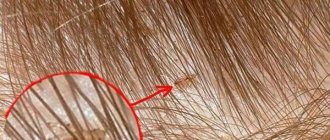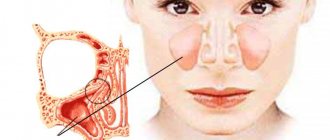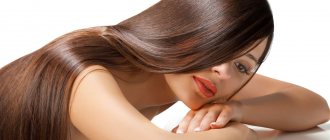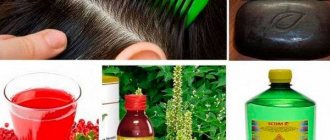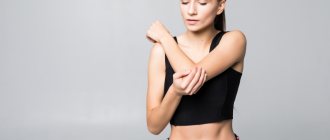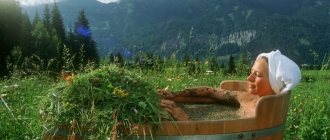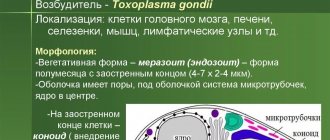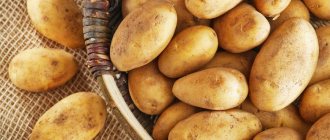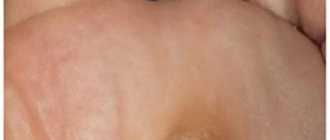Causes
There is an opinion that pediculosis occurs most often in children from disadvantaged families with low social status, where there are no basic conditions for personal hygiene. But this is not true; any child can become infected with head lice. Most often, infection occurs in kindergartens or schools, as well as in holiday camps and in hospital settings for inpatient treatment of children. Lice crawl from a sick child to a healthy one and begin to actively multiply. Females lay eggs called nits, which look like white balls at the base of the hair (about a centimeter from the root of the hair). They can be confused with dandruff, but nits cannot simply be shaken off; they are firmly glued to the hair.
The main routes of transmission of the disease:
- directly from an already infected person or another child;
- infection through other people's combs, hairpins, hats, ribbons;
- when using shared bed linen or towels;
- in public transport through head restraints.
Girls with long, loose hair are more likely to get lice, so it is better to wear their hair in braids.
Examination of a child for pediculosis
Where do lice come from and how to deal with them
2018-09-15 City Disinfection Station
Pediculosis is a fairly common disease that is caused by small blood-sucking insects - lice. Most often you have to deal with head lice, which find refuge in human hair and become the cause of lice or, what is much more dangerous, typhus, since they are its carriers. Despite the fact that the standard of living of people is constantly increasing, according to world statistics, the percentage of infection with this disease, even in developed European countries, is not decreasing.
What is a head louse?
A louse is a small blood-sucking insect that cannot fly or jump, but thanks to the structural features of its clawed legs, it moves easily and nimbly in human hair. It prefers to inhabit mainly the occipital, parietal and temporal zones of the head, but as populations increase, they occupy the entire area. This small, elongated parasite has a body 2–3 mm long, light gray in color, which changes to brownish-brown when saturated with blood, and can also masquerade as hair color.
Insects are highly fertile; one adult female lays 10 eggs daily - nits, which after 12 days turn into a full-fledged insect and the cycle repeats again. During her life (28–30 days), an adult female manages to lay up to three hundred nits, firmly attaching them to her hair with a special adhesive substance that is not affected by detergents and frequent combing. Therefore, if serious measures are not taken to combat them, the population will grow exponentially.
Methods and symptoms of infection
You can only become infected with this unpleasant disease through contact from another person. This can happen while traveling in public transport, especially crowded ones, and can be transmitted through clothing, underwear, and combs. Most often, head lice occurs in children of preschool and school age, regardless of the well-being of the family and their attitude to hygiene, since children's games contribute to very close communication.
It is quite difficult to quickly determine the appearance of lice, since due to their size and agility they are difficult to see with the naked eye. But a number of signs may indicate their presence:
- A person is bothered by severe and frequent itching of the skin under the hair.
- New red dots or small pustules constantly appear.
- A rash may appear under the hair on your neck.
- Lice can cause swollen lymph nodes.
- You can find small shiny light-colored or hair-colored hard balls firmly attached to the hair.
If at least one of these signs occurs, you should immediately examine your hair, preferably with a magnifying glass. If a louse is found, it is necessary to begin treatment immediately, since delay threatens the complete occupation of your hair by parasites. However, if you are unsure, visit a doctor.
How to identify lice
If you suspect that your child has lice, you should sit him in a well-lit place and carefully examine his head over a table covered with a white cloth or paper. It is very difficult to notice adult individuals, since they are very active and quickly hide from the light, but you can see their eggs, which in the form of oval shiny light balls are firmly held on the hair near the root. In order not to confuse them with dandruff and debris, try to shake them off; this is impossible to do with nits; they are even difficult to remove with your hands. Wet your child's hair and begin combing the hair with a special fine-tooth comb.
How to cure pediculosis?
If lice are found, contact your pediatrician, who will recommend an effective and reliable remedy. Today, pharmacology offers many chemical agents to combat lice; they are available in different types and consistencies. These can be lotions, shampoos, sprays with different percentages of toxins, and therefore effectiveness. Therefore, choosing the safest means is not always rational, since treatment will require a very long time and a large number of treatments.
The effectiveness of treatment depends on the correctness of its implementation. The selected product is applied to the hair strand by strand from the roots and along the entire length of the hair and left for a certain time, it is indicated in the instructions for use. In order not to harm the child, it is not worth increasing this time due to toxicity. Then the product is washed off and dead insects are combed out of wet hair. If after the procedure you find a live louse, it means that somewhere the process was disrupted or the product was ineffective.
It must be said that it will never be possible to get rid of unpleasant inhabitants in one treatment, no matter how effective the drugs are, since they kill only adult individuals, while the nits remain alive and unharmed. They are protected from the effects of many chemicals by a durable chitinous shell, so you can only get rid of them by combing them out. To ensure that nits come off the hair easily when combing out, it is recommended to moisten the hair with a vinegar solution (1 part vinegar 9% diluted with 2 parts water). The acid softens the adhesive that attaches the eggs, and they easily fall away under the comb.
Therefore, hair treatment will have to be carried out several times every 7 - 10 days, usually 2 - 3 times are enough. The main thing is to have time to destroy the newly hatched individuals before they reach sexual maturity. If lice are found in one family member, then everyone needs to be checked and a one-time treatment is carried out for prevention.
How to prevent lice
It is simply impossible to protect yourself and your children 100% from the appearance of lice, but minimizing this is quite possible. To avoid infection, you should not use other people's personal belongings, such as combs, towels, and hats. Also visit untrustworthy hairdressing salons and spa salons, periodically check the hair of all family members, especially children after holidays in camps and at the beginning of the school year.
Author of the material: Vladimir Egorov
Disinfector Experience in the field for more than 7 years
Symptoms of childhood lice
Pediculosis is not difficult to recognize. The main symptoms of infection appear in children as follows:
- severe itching of the head appears as a result of lice bites. The child often scratches his head, especially hard behind the ears, where the skin is thinnest;
- red bite marks are visible under the hair, the skin is inflamed and irritated;
- You can see nits on the hair. One adult female louse lays about 10 eggs per day;
- in advanced forms of the disease, the lymph nodes behind the ears become inflamed.
Main signs of pediculosis
The main signs of the disease are:
- 1. Itching. Occurs predominantly in the occipital region. It is noteworthy that itching is present in only 14-36% of infected people.
- 2. Insomnia. Lice feed at night, so the itching can intensify at this time, disturbing sleep.
- 3. Redness and sores. Most often appear on the back of the head and in the neck area.
- 4. Adult lice. They are not easy to see, as the insects move quickly along the hair, hiding from the light.
- 5. Nits. These are lice eggs. They are tiny, light brown in color, and oval in shape. Adults attach them to the hair closer to the scalp. Nits cannot be removed with a regular hair comb.
Treatment of pediculosis in children
Nowadays, pharmacies sell many different effective remedies for head lice for children in the form of shampoos, lotions or sprays.
So how to treat pediculosis in children? The main thing is that the treatment must be combined; it is necessary to destroy not only adult insects, but also their eggs. You can choose the tool that is most convenient for use. The main active ingredient against adult lice, which is part of most drugs, is permethrin. These are new generation drugs that are toxic to insects and harmless to humans. To achieve the desired result, you must strictly follow the instructions and pay attention to the age at which you are allowed to use this or that product.
After treating the head with medications, it is necessary to comb out all nits from the hair using a fine comb, since the poison does not affect them. To facilitate this process, it is recommended to moisten the comb in a heated solution of acetic acid. To prevent relapse of head lice, you should be patient and try to remove all nits the first time.
Traditional medicine offers its own recipes for the treatment of pediculosis in children . It is recommended to treat the scalp with kerosene, vinegar, tar soap, and cranberry juice. Any of the listed products is applied to the scalp and hair for 40 minutes, covered with plastic wrap, and then washed thoroughly.
How to remove lice
- • Home remedies. There are many recipes for treating head lice at home. These include: kerosene, vinegar, essential oils, etc. If you choose this treatment method, you must be prepared for the fact that the fight against parasites will take some time.
- • Pharmacy drugs With the development of medicine, a large number of effective anti-pediculosis drugs have appeared. Their only drawback is that lice develop resistance (become resistant) to insecticide-based preparations
- • Mechanical method. Probably the oldest way to fight head lice. It consists of regularly combing adults and removing nits.
Prevention
To prevent head lice in children, the following measures should be taken:
- prohibit wearing other people's hats or hair clips;
- teach your child to maintain personal hygiene;
- explain to him that he should have his own comb.
Preventive examination of children for pediculosis
After a child arrives home from a camp or sanatorium, a preventive examination for pediculosis of his head should be carried out. If lice or nits are found, you should immediately begin removing them and take preventive measures for members of the entire family.
Vinegar
The main disadvantage of this method is that vinegar does not kill adult lice. It simply lacks the properties to do this. However, the acid in vinegar can kill nymphs, young fish that are not yet able to lay eggs. Therefore, the anti-pediculosis effectiveness of vinegar is a controversial issue. However, vinegar does help in the fight against nits. Acetic acid does not dissolve the exoskeleton (the protective shell of nits), and therefore does not kill them. However, it weakens the glue that holds nits on the hair shaft and makes them easier to remove mechanically. To treat with 9% vinegar, it must be mixed with water in a ratio of 1:2, applied to hair, covered with film and left for 30 minutes.
Mechanical method - combing
The number one enemy of lice and nits is the fine-tooth comb. It is almost impossible to successfully get rid of lice without this assistant. Studies have shown that mechanical combing is even more effective than pediculicide treatment. First of all, a fine-tooth comb is the easiest way to diagnose lice. Dermatologists say that diagnosing head lice using a comb is four times more effective and twice as fast as direct visual examination.
Treating lice with a comb is not an easy process, but it is very effective if done correctly. Apply a thick conditioner mixed with a pinch of baking soda to your hair. It will make combing easier. Separate your hair into sections and comb out, starting straight from the scalp. After each stroke, clean the comb with a napkin or paper towel. The procedure must be repeated daily for two weeks until the parasites completely disappear.
Mayonnaise
Mayonnaise is an excellent sauce that is found in almost every kitchen. However, few people know that it can be used to treat head lice. The technique is that viscous mayonnaise closes the respiratory channels of parasites, as a result of which they die from suffocation. People who have tried this product recommend using thick, high-fat mayonnaise. It is applied generously to the hair and the head is covered with film. The sauce is left on the hair for half an hour, after which it is washed off with shampoo. Some people recommend leaving mayonnaise on your hair overnight to increase the effectiveness of treatment.
Is it possible to remove lice in 1 day?
Unfortunately, you can only get rid of lice in 1 day using a very radical method - shaving your head. However, before resorting to it, consider the following points:
- • You cannot bring a child with lice to the hairdresser. And shaving your head yourself can lead to cuts and infection.
- • Shaving can upset the child and mean temporary isolation. Many children are very embarrassed by such a radical hairstyle, as well as the reason why their parents resort to it.
- • For girls, a shaved head remains a social taboo.
- • In order to be sure to get rid of lice, you will need to completely shave your hair. Parasites cling to even the shortest hairs, so cutting with a clipper will not be enough
Is reinfection possible?
The likelihood of re-infection with lice at home is very low. However, it is worth washing your child’s bedding at a high temperature. Soft toys can be placed in a sealed plastic bag and left for two days. Contrary to popular myth, lice don't care whether a child's hair is clean or dirty. Therefore, frequent washing does not protect you from lice. The best advice is to avoid direct contact with other people. It is better to wear long hair in a ponytail or braid.
Herbs for lice
Among the various ways to get rid of lice, there are recipes based on medicinal herbs. Decoctions or infusions are prepared from them for washing or rinsing hair. Many people consider them safer, although in some cases herbs can cause allergic reactions.
Among the herbs for lice used in traditional medicine, we highlight:
- • wormwood – the effectiveness of the plant is achieved thanks to its composition, which contains amino acids, tannins, and essential oils;
- • hellebore - an alcohol tincture is prepared from its root for hair treatment;
- • tansy – the herb of the plant is boiled in a water bath and applied to the hair;
- • larkspur – a decoction for treating the head is prepared from grass or plant seeds;
- • burdock – the plant is used in dry or fresh form; a decoction prepared from burdock is used to wash hair.
The list of herbs with insecticidal properties also includes mint, elecampane, geranium, and black cumin.
Most often, decoctions are prepared from crushed herbs in a water bath. The prepared herb is poured with boiling water and kept over low heat for 15-20 minutes. After this, you can wash or rinse your hair with the broth. Infusions are also prepared on its basis.
Compresses are prepared from decoctions and infusions and applied to the hair and scalp. After an hour, wash off the compress with warm water and wash your hair with shampoo.
The effectiveness of herbs in eliminating lice and nits will be achieved only after repeated use, at intervals of 2-3 days.
Anti-lice herbs are not recommended for pregnant and lactating women, as well as persons with individual intolerance to the active substances of plants.
It should be borne in mind that some herbs can be poisonous, so before using them to combat lice, it is necessary to study the properties of the plants.
If nausea, vomiting, dizziness and deterioration in general health occur while treating the head with herbal decoctions, the procedure should be stopped.
How to protect yourself from lice infestation?
The main method of prevention is to avoid close contact with the head of an infected person. This is difficult to explain to a small child. But teenagers need to understand this simple rule, especially since recent head lice outbreaks around the world have been linked to the habit of taking selfies with children's heads touching. You should also teach your child not to use other people's combs, even though the likelihood of lice being transmitted this way is extremely low.
As a preventive measure, you can use essential oils, especially geranium oil, the smell of which repels lice. You can add a few drops of this oil to your shampoo. Girls with long hair can apply a few drops of oil directly to their hair.
How to quickly remove lice?
The main mistake that parents make when treating lice is the incorrect use of pharmaceutical products. When treating, be sure to take into account the life cycle of parasites. Most pediculicides do not penetrate the well-protected shell of nits, so treatment must be repeated after 7-10 days, when nymphs hatch from the nits.
Many parents, desperate to cope with lice, spend a lot of effort cleaning the house, suspecting that the child is re-infected with lice through household items. Meanwhile, parasitologists say the fight should be focused on the baby's head, not the environment
A 2010 study published in the journal Open Dermatology found that the risk of transmission from combs, hats and toys is very low. Scientists tested students who had a total of more than 5,500 head lice. However, no parasites were found on their hats. The same goes for floors: When researchers checked the floors of 118 classrooms in a school with a head lice outbreak, no lice were found on them.
How to prevent relapse and spread
An important step in the treatment of head lice in children is the prevention of re-infection. The patient's clothes and bedding need to be boiled, ironed, and pockets, hoods and seams checked for parasites.
During treatment, you should not visit public places to prevent infecting other children.
We have already noted that anyone can become infected with lice, and there is nothing “inconvenient” about this disease. The fact that a child is sick with head lice must be notified to the kindergarten teacher or school teacher, as well as the parents of other members of the children's team, so that they can take preventive measures to prevent other children from becoming infected.
Kerosene
This remedy has been used for a long time and, indeed, has a pronounced anti-pediculosis effect. Kerosene is mixed with vegetable oil in a ratio of 1:10. For this purpose, you can use olive, sunflower or corn oil. The resulting mixture is evenly applied to the hair using a cotton swab, the head is covered with film and the product is left for 15 minutes. Before removing lice from a child using this method, keep in mind that kerosene is a toxic and flammable substance. Therefore, this recipe cannot be called safe.
